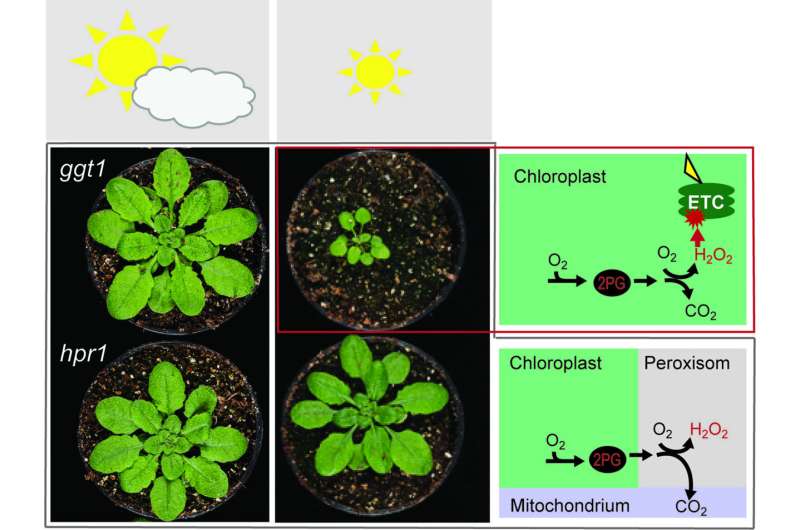This article has been reviewed according to Science X's editorial process and policies. Editors have highlighted the following attributes while ensuring the content's credibility:
fact-checked
peer-reviewed publication
trusted source
proofread
Research shows that photorespiration does not protect against fluctuating light conditions

Photosynthesis is one of the most important metabolic processes in nature: It is critical for plant growth and thus for the production of plant-based foods. In close cooperation with the Max Planck Institute of Molecular Plant Physiology (MPI-MP), a German-American research team headed by Heinrich Heine University Düsseldorf (HHU) has now investigated whether a specific metabolic pathway in photosynthesis that competes with carbon fixation has a protective function for plants.
The results are also relevant for crop plant breeding, as the researchers explain in the journal Nature Communications.
During photosynthesis, plants convert energy from light into chemical energy. This chemical energy takes the form of special molecules: ATP and NAD(P)H. The energy stored in these molecules can be universally used for other metabolic processes in the plant, for example to fix carbon dioxide (CO2) from the air in the form of hydrocarbons such as sugar.
The catalyzing protein "Rubisco" is important for this process. However, Rubisco not only fixes CO2, but also—as an unwanted side reaction—oxygen. In the process, the toxic by-product 2-phosphoglycolate is generated, which in turn compromises CO2 fixation. In order to eliminate the disruptive 2-phosphoglycolate, a further energy-intensive metabolic process is necessary: photorespiration.
Over the course of the day, light intensity fluctuates sharply—for example when the wind blows leaves around or due to cloud. Accordingly, the amount of chemical energy available in the form of ATP and NAD(P)H also fluctuates. It can be harmful for the plant if it is suddenly exposed to strong light: As only limited amounts of the precursor molecules for ATP and NAD(P)H are available, only part of the absorbed light energy can be converted into chemical energy. Excess light energy causes so-called photooxidative damage to proteins, which inactivates them.
A research team headed by Professor Dr. Ute Armbruster from the HHU Institute of Molecular Photosynthesis has now investigated whether photorespiration can protect plants from photooxidative damage in sharply fluctuating light conditions. Their hypothesis: Photorespiration uses up excess chemical energy, releasing sufficient precursor molecules for the production of ATP and NAD(P)H.
Researchers from the Max Planck Institute of Molecular Plant Physiology in Potsdam, the University of Potsdam and Michigan State University in East Lansing were also involved in the project.
The object of the study was thale cress (Arabidopsis thaliana), whereby the genes for HPR1 and GGT1 were switched off in some of the plants (so-called knockout plants). These genes encode two key enzymes for photorespiration, which can be found at different points along this metabolic pathway. The plants were exposed to different light conditions: fluctuating light and constant light at two intensities.
The researchers observed how the plants grew in the different lighting situations. According to the hypothesis, the plants with limited photorespiration should grow less well under sharply fluctuating light conditions as photorespiration cannot take on a protective function here.
Dr. Thekla von Bismarck, lead author of the study says, "Our hypothesis was not confirmed: Photorespiration appears not to play a key role in protecting plants during phases of strong light in fluctuating light conditions. In fact, plants without a fully functioning photorespiration process appear to grow better under fluctuating light than constant light conditions."
The cooperation partners in Potsdam contributed a computer model, which forecasts various metabolic processes, to the study. Professor Armbruster says, "Plant metabolism proved very flexible. Even though the plants lack certain photorespiratory enzymes, they are able to compensate this lack via other metabolic pathways. The alternative pathway is however dependent on the light condition and, for plants without GGT1, we were able to show that fluctuating light activates a less harmful metabolic pathway in terms of photooxidative damage than non-fluctuating light."
The results are interesting in the context of improving crop yields by synthetically bypassing photorespiration. The activation of a plant's own alternative metabolic pathway in the chloroplasts could be used to release the CO2 from photorespiration in the vicinity of Rubisco and thus improve photosynthesis under dynamic light conditions.
More information: Thekla von Bismarck et al, Growth in fluctuating light buffers plants against photorespiratory perturbations, Nature Communications (2023). DOI: 10.1038/s41467-023-42648-x
Journal information: Nature Communications
Provided by Heinrich-Heine University Duesseldorf




















